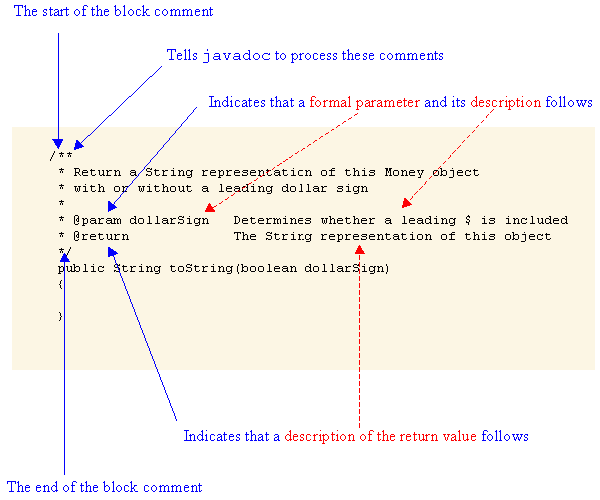Table of Contents
The Java Documentation Generator (javadoc)
Overview
javadoc is a tool that creates HTML pages (often called “java docs”) from documentation included in Java source files.
javadoc looks for specially-formatted block comments (that start with /** and end with */) for information to include in the HTML pages it creates. These comments include a main description followed by one or more tags.
Tags for Constructors and Methods
The most frequently-used tags for constructors and methods are:
- @author text
- @deprecated text
- @param nametext
- @return text
- @since text
- @throws classtext
Below is an annotated example of a method that contains javadoc-formatted comments:
Tags for Classes and Interfaces
The most frequently-used tags for classes and interfaces are:
- @author text
- @deprecated text
- @since text
- @version text
An Example
Below is a descriptive example of a class that contains javadoc-formatted comments:
/** * This is where the description of the class goes. * You can include HTML tags if you would like. * * @author Author's name * @version Version number */ public class ClassName { /** * This is where the description of the method goes. * * @param param1 Description of the first parameter * @param param2 Description of the second parameter * @return Description of what is returned */ public ReturnType methodName(Type1 param1, Type2 param2) { } }
Executing the Tool
The javadoc tool can be executed at the command line. It has the following syntax:
| javadoc [options] [packages] [files] |
For example:
javadoc Calculator.java Controller.java
will create the HTML pages for the source files named Calculator.java and Controller.java.
Many integrated development environments also have the capability of running the javadoc tool, including Eclipse.
Note that the javadoc tool generates a large number of “supporting” files even if you only generate documentation for a single class. The file index.html is the “main” page.
Troubleshooting
If you're style-checker gives you a message like @param tag must be preceeded by a blank line, it probably means that there is extra whitespace on the line the line containing the @param tag. Delete anything (even if you can't see it) that is after the asterisk on the “blank” line.
For More Information
The javadoc tool is very powerful and has a number of capabilities that are not discussed here. For more information, see:
